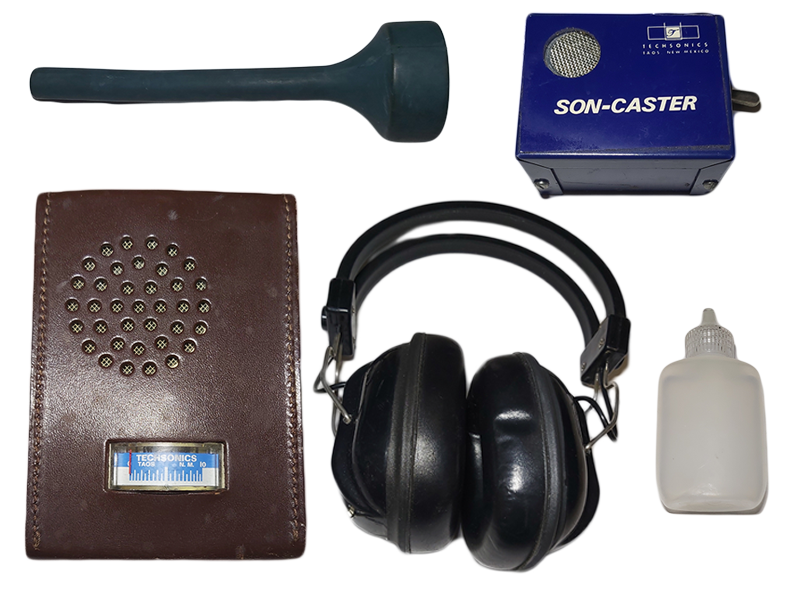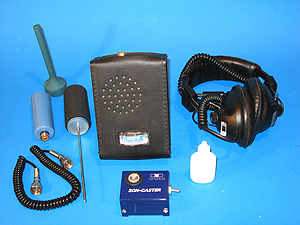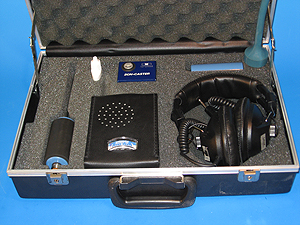
Steam Trap Leak Detectors for Sale
- A cost-effective solution for frequent testing
- Have your own ultrasonic steam trap leak detection unit on-hand anytime
- Long-term cost savings for multiple steam trap audits.
Steam traps have a tendency to leak, which can add up to hundreds of dollars per year of wasted steam for a single steam trap. This was probably less important when the original steam system was built years ago, but with today’s energy prices, it is critical to detect and correct failures quickly.
Keystone sells a variety of ultrasonic steam trap leak detectors. See below for available makes and models.
Available Steam Trap Leak Detectors
Scroll the chart below for an overview of the leak detectors we have available for sale, as well as leak detector parts and components.
Please contact us for questions, quotations and inquiries.
Download specific information on how the Sontector operates. Or click here to view all the pages as a single PDF file.
Sontector PDF - All Pages
Contact Us
Do you still have questions? Are you looking for pricing information or to place an order?
Do you have questions about steam trap leak detection?
What issues can be caused by a leaking steam trap?
A leaking steam trap can…
- Waste valuable heating $$$
- Destroy condensate pumps
- Create hot and cold spots within a heating space
- Cause production inefficiency of process equipment
- Produce destructive water hammer
- Lead to undue wear on, and premature failure of, other traps
What are some of the ways to check for a leaking steam trap?
How do you know if you have leaking steam traps? Checking your condensate return pumping unit is a good start. If there is steam coming out of the vent under pressure (not flash steam) – that is a good indication that you have one and probably more than one leaking trap.
- TEMPERATURE…Some people feel that a hot return line from the trap indicates a leak. Not true! A trap which is cycling properly will discharge condensate near saturated steam temperature. Obviously, the return line will be hot also.
- TEMPERATURE DIFFERENTIAL…Using a temperature probe to take reading immediately before a trap and immediately after the trap. The theory here is that there should be a dramatic temperature differential between the two readings (steam on one side and condensate on the other) to determine if the trap is working, or little temperature differential which would indicate that the trap has failed. Sometimes this works. However, if there are multiple traps within close proximity to one another and all are sending condensate to a common collection pipe, and if just one of those traps has failed in the open position (common), the steam will back up into the other outlet pipes causing a false reading (steam on the inlet side and steam on the outlet side).
- OBSERVATION…Observing the discharge from the traps is the only positive way of checking the operation of a steam trap. Only then can you determine whether the trap is cycling properly and if it closes tightly. To do this in a closed system, it is necessary to valve the discharge at each trap so that the discharge from that trap is isolated from the rest of the system and the condensate can be dumped to atmosphere from the trap body. This can generally be accomplished fairly easily with Float & Thermostatic traps (especially those of the ‘H’-Configuration as supplied by Barnes & Jones and Edison) and with Bucket Traps. However, installing a discharge ‘T’ on Thermostatic traps with the required ball valve would undoubtedly prove to be too costly.
- INSTALLED SYSTEMS…Several systems exist where test chambers are installed at critical steam trap locations which continuously monitor the performance of the associated steam trap. Some of these systems can be wired to a remote facility so that real-time performance can be observed and/or recorded. Other systems require that the test chambers be checked manually with a probe to determine the performance of the trap. Two manufacturers of this style of monitored observation are Spirax Sarco and Armstrong. These are very accurate but require a major financial investment.
- ULTRASONIC…This is undoubtedly the most convenient and least intrusive method of locating faulty steam traps.
What is 'Ultrasonic' steam trap leak detection?
Most leaks generate ultrasonic noises which are inaudible to the human ear. It is simple to find problems with a tool designed to hear ultrasonic noises generated by the problem itself, and not hear interfering background noises. Leaking Steam Traps generate sounds in the 35,000 – 45,000 cycles per second region. The Ultrasonic Steam Trap Leak Detector converts and amplifies the 35,000 – 45,000 cycles to frequencies that can be heard by the human ear. The user can hear and evaluate whether the sound is normal or abnormal based on his/her real world experience. A good steam trap sounds one way, a faulty steam trap sounds another. It takes just a few trials to be comfortable with the differences.
The Ultrasonic Leak Detector is simple to use and highly reliable. It does not rely on temperature or temperature differential – its only requirement is that the trap cycles. Each Ultrasonic Unit comes complete with a base unit, a contact probe, microphone hand probe, ultrasonic noise generator (optional), concentrator cone, headphones (for noisy environments) and test kit. All are packaged in a sturdy carrying case. To test steam traps, the contact probe is used and the tip is placed on the steam trap. Since all steam traps work on an open/close cycle, it is easy to determine whether the probe is picking up an open/close cycle or a steady open cycle. ‘Open/close’ generally means the trap is good, ‘constant open’ means the trap has failed. However, even if the trap is cycling properly, the trap seat may be damaged by scouring, pitting, or wire wicking allowing some steam to escape even when in the closed position. This ‘partial failure’ can be picked up by the ultrasonic leak detector
The microphone hand probe (acoustic probe) hears airborne ultrasonic sound generated by compressed air and gas leaks, vacuum leaks, and corona discharge. It is also used in conjunction with the optional ultrasonic noise generator to locate pin hole leaks in seals, containers, vans, and tanks. Far faster and easier than soap bubbles.
How much does purchasing a leak detector cost?
Please contact us directly and request a quote on the model of steam trap leak detector you would like to request pricing for.
Can I rent a steam trap leak detector instead?
Keystone operates a steam trap leak detector rental program within Canada. Visit our leak detector rentals page for details about how this program works and the leak detectors we have available to rent.
Can I hire Keystone to conduct a steam trap survey?
As long as you are local, Keystone is available to hire for a steam trap survey. Visit our steam trap surveys page for more information.
What are the component pieces of a leak detector?
A steam trap leak detector contains common component pieces, although these may vary from model to model. Generally, however, these models contain:
- Base Unit – receives sound from the test source and coverts it to audible levels heard either through the base unit speaker or headphones. Also visually using the meter. Comes with leather case with belt clip.
- Coiled cable is used to attach either the Contact Probe or Acoustic Probe to the Base Unit.
- Contact probe is used for testing steam traps, condensers, bearings and other pieces of equipment. The tip of the probe is touched to the equipment being tested and the ultrasonic vibrations are sent to the base unit for interpretation and amplification.
- Acoustic probe used for airborne ultrasonic vibrations caused by compressed air, gas and vacuum leaks (locates the source in a general area which is pin-pointed by the sound concentrating cone). Also used to detect corona discharge. Can be used with the Ultra-sonic noise generator to locate small leaks in any sealed container or tank.
- Sound concentrating cone is a flexible rubber funnel that slips over the acoustic probe to ‘zero-in’ on the source of the airborne vibrations detected by the acoustic probe and pin-point the source of the leak to within ¼”. The flexible rubber allows bending around pipes or other obstructions to reach locations difficult to access.
- Ultrasonic noise generator is used for when locating non-pressure leaks. When placed within a sealed container and turned on, the area is filled with ultrasonic sound. Using the acoustic probe (and concentrating cone) the leak can be detected from the outside of the container. Very handy for vacuum seal and gasket leaks.
- Headphones are used in noisy environments where the sound from the built-in loudspeaker cannot be heard or is difficult to hear.
- Squeeze bottle is used with the acoustic probe to test the unit for proper operation.
- Carrying Case keeps and protects all components in one handy location.
These are the component pieces of a packaged Son-Tector 123 Unit
This is the same Son-Tector 123 unit in its packaging.
